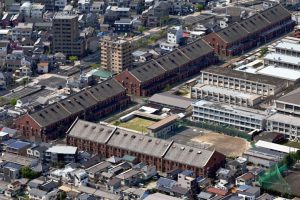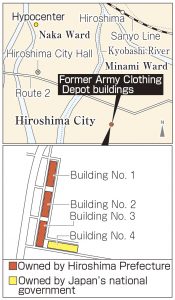All four Army Clothing Depot buildings now slated for preservation, with national building set to undergo seismic reinforcement for protection against earthquakes
May 18, 2022
by Yo Kono, Staff Writer
On May 17, it was learned that among the four so-called former Army Clothing Depot buildings, located in Hiroshima’s Minami Ward and among the largest A-bombed structures remaining, the national government has decided to retrofit the one building it owns with reinforcement to protect against earthquakes. The national government’s plan is in line with Hiroshima Prefecture’s plan to proceed with seismic reinforcement of the three buildings of the four that it owns. All four buildings, the subject of heated debate regarding whether they should be preserved or demolished and known as “silent witnesses” to the atomic bombing, seem now to be headed for preservation.
According to several sources, a detailed survey of the national government-owned building No. 4 conducted by the Chugoku Finance Bureau in fiscal 2021, which manages the structure, revealed that the brick walls and concrete had sufficient strength and that the risk of collapse was low. However, the survey also revealed that the building required a minimum level of reinforcement for protection against earthquakes.
As a result, from the viewpoint of ensuring the safety of local residents, the Chugoku Finance Bureau will proceed with safety measures on the building including seismic reinforcement. The bureau plans to launch a bidding process for plans to implement the reinforcement work as early as this summer. Detailed construction methods and utilization measures involved in the building’s preservation will be determined on the basis of cooperation between the prefectural and city governments.
In May 2021, the prefectural government, the owner of buildings No. 1–3, decided to implement reinforcement work in the three buildings based on the results of its own additional survey regarding their level of resistance to earthquakes. The cost of construction work for each building was estimated to be around 580 million yen. The results of the Chugoku Finance Bureau’s survey are nearly identical to those of the additional survey conducted by the prefectural government, and the construction cost per building according to the bureau’s survey will probably be along the lines of the estimates provided by the prefectural government.
In December 2019, as the prefectural government formulated a draft proposal for safety measures in which it was determined that two of the buildings would be demolished and the outer appearance of the third building would be preserved, the national government was also considering the demolition of building No. 4, among other plans. In response to opposition from A-bomb survivors’ groups, however, the prefecture reversed its policy and decided in effect to preserve the three buildings. The national government then indicated its intent to follow suit. Securing the preservation expenses involved and coming up with plans to utilize the buildings are issues that apparently will be discussed in the future.
Former Army Clothing Depot
The former Army Clothing Depot was a facility once used to manufacture military uniforms and footwear for the former Imperial Japanese Army. The facility buildings, located 2.7 kilometers southeast of the hypocenter, were completed in 1913. After the atomic bomb was dropped, the buildings were used as temporary relief stations for A-bomb survivors. The depot originally consisted of 13 buildings, but only four, situated in an L-shaped configuration, remained after World War II. They were used as warehouses for private corporations and as a student dormitory for Hiroshima University. Hiroshima Prefecture owns buildings No. 1–3, while building No. 4 is in the possession of Japan’s national government. The Hiroshima City government registered the buildings as A-bombed buildings in 1994, and since around 1995, the buildings have not been used. Now more than 100 years old, the structures show significant deterioration.
(Originally published on May 18, 2022)
On May 17, it was learned that among the four so-called former Army Clothing Depot buildings, located in Hiroshima’s Minami Ward and among the largest A-bombed structures remaining, the national government has decided to retrofit the one building it owns with reinforcement to protect against earthquakes. The national government’s plan is in line with Hiroshima Prefecture’s plan to proceed with seismic reinforcement of the three buildings of the four that it owns. All four buildings, the subject of heated debate regarding whether they should be preserved or demolished and known as “silent witnesses” to the atomic bombing, seem now to be headed for preservation.
According to several sources, a detailed survey of the national government-owned building No. 4 conducted by the Chugoku Finance Bureau in fiscal 2021, which manages the structure, revealed that the brick walls and concrete had sufficient strength and that the risk of collapse was low. However, the survey also revealed that the building required a minimum level of reinforcement for protection against earthquakes.
As a result, from the viewpoint of ensuring the safety of local residents, the Chugoku Finance Bureau will proceed with safety measures on the building including seismic reinforcement. The bureau plans to launch a bidding process for plans to implement the reinforcement work as early as this summer. Detailed construction methods and utilization measures involved in the building’s preservation will be determined on the basis of cooperation between the prefectural and city governments.
In May 2021, the prefectural government, the owner of buildings No. 1–3, decided to implement reinforcement work in the three buildings based on the results of its own additional survey regarding their level of resistance to earthquakes. The cost of construction work for each building was estimated to be around 580 million yen. The results of the Chugoku Finance Bureau’s survey are nearly identical to those of the additional survey conducted by the prefectural government, and the construction cost per building according to the bureau’s survey will probably be along the lines of the estimates provided by the prefectural government.
In December 2019, as the prefectural government formulated a draft proposal for safety measures in which it was determined that two of the buildings would be demolished and the outer appearance of the third building would be preserved, the national government was also considering the demolition of building No. 4, among other plans. In response to opposition from A-bomb survivors’ groups, however, the prefecture reversed its policy and decided in effect to preserve the three buildings. The national government then indicated its intent to follow suit. Securing the preservation expenses involved and coming up with plans to utilize the buildings are issues that apparently will be discussed in the future.
Keywords
Former Army Clothing Depot
The former Army Clothing Depot was a facility once used to manufacture military uniforms and footwear for the former Imperial Japanese Army. The facility buildings, located 2.7 kilometers southeast of the hypocenter, were completed in 1913. After the atomic bomb was dropped, the buildings were used as temporary relief stations for A-bomb survivors. The depot originally consisted of 13 buildings, but only four, situated in an L-shaped configuration, remained after World War II. They were used as warehouses for private corporations and as a student dormitory for Hiroshima University. Hiroshima Prefecture owns buildings No. 1–3, while building No. 4 is in the possession of Japan’s national government. The Hiroshima City government registered the buildings as A-bombed buildings in 1994, and since around 1995, the buildings have not been used. Now more than 100 years old, the structures show significant deterioration.
(Originally published on May 18, 2022)









